I have all the front end prothane inserts but I can’t comment specifically on them for another week or two. I’ve been chasing a couple small front end adjustments and I think I have them all sorted. I’m hoping I get a chance to give a new opinion on these soon. I was Surprised to see Acura techs not adjust some of the caster points properly until I literally went under the car with the last place where I knew someone and we got an amazing number equal on both sides at 9.1 positive degrees. I was at 6.8-7.7 degreees on the previous alignment job. Nothing to do with the bushings but I expect the car to feel different next time I take it out.
-
Protip: Profile posts are public! Use Conversations to message other members privately. Everyone can see the content of a profile post.
You are using an out of date browser. It may not display this or other websites correctly.
You should upgrade or use an alternative browser.
You should upgrade or use an alternative browser.
Experiences with Prothane bushing kit?
- Thread starter Ap2GT3
- Start date
I have all the front end prothane inserts but I can’t comment specifically on them for another week or two.
Looking forward to your feedback.
That's the stuff I've had great luck with. I trird to order it too (can't recall from where) but despite it showing a pic of the old stuff, I received the Alum version!
The product numbers are the same. I suspect its just a change in packaging, although I don't see the upside to labeling it aluminum. In the past I have seen it labeled as silver anti seize on smaller bottles. The older TDS sheets show the constituents being aluminum, copper and graphite which appears unchanged for the most recent stuff. I suppose that it is possible that they have altered the concentration of aluminum; but, that would typically trigger a change in product number..
Last edited:
I was hoping you were right when I reordered. SKU is the same but the formulation was noticeably different. I'm far from a chemist but the formulation of the prior stuff was higher in lubricity with less "grain" in it. It was also more brown than silver in color. I know this isn't a scientific explanation but I did several months of testing between these two for another application. I prefer the first formulation for any Alum to Rubber mating surfaces. Mine in particular was for a pneumatic application.The product numbers are the same. I suspect its just a change in packaging, although I don't see the upside to labeling it aluminum. In the past I have seen it labeled as silver anti seize on smaller bottles. The older TDS sheets show the constituents being aluminum, copper and graphite which appears unchanged for the most recent stuff. I suppose that it is possible that they have altered the concentration of aluminum; but, that would typically trigger a change in product number..
I was hoping you were right when I reordered. SKU is the same but the formulation was noticeably different. I'm far from a chemist but the formulation of the prior stuff was higher in lubricity with less "grain" in it. It was also more brown than silver in color. I know this isn't a scientific explanation but I did several months of testing between these two for another application. I prefer the first formulation for any Alum to Rubber mating surfaces. Mine in particular was for a pneumatic application.
Interesting. Permatex has different part numbers for US versus Canada; but, I thought that was just be a packaging thing because the bottles have to be labeled in French and English for Canada. I have an ancient bottle (> 10 years) and a fresh bottle of what is labeled Permatex 'Silver Grade'. Both are definitely very very very silver, the old one just getting very stiff. The only brownish component is the petroleum solvent which separates out after sitting for awhile and can be stirred back into the silver paste. For the small 113 gm bottle I have the old part number was 80558 which now cross lists to 76762 which is still called Silver Grade.
80558 Permatex Silver Grade Anti-Seize, 113-g — Partsource
76762 is a Cdn part number which cross lists to 80071 for the US. However, in the US the label changes to aluminum. I had assumed that because of the part number cross list that they were the same thing; but, perhaps the Silver Grade is different from the aluminum. The very old and new bottles of silver grade that I have are the same color, the old just getting to the point that its more like the Loctite QuickStikk solid anti seize that I have which is also called 'Silver Grade'.
well... I just bought yet another set of parts I probably will never install in my lifetime.
For the folks that order this - keep in mind you can buy this in subsets. The master set comes with sway bar bushings which you probably don't need if you're on aftermarket bushings. You can order the front and rear separately.
For the folks that order this - keep in mind you can buy this in subsets. The master set comes with sway bar bushings which you probably don't need if you're on aftermarket bushings. You can order the front and rear separately.
well... I just bought yet another set of parts I probably will never install in my lifetime.
For the folks that order this - keep in mind you can buy this in subsets. The master set comes with sway bar bushings which you probably don't need if you're on aftermarket bushings. You can order the front and rear separately.
I'm going to install the front ones this weekend- I'll report back.
Any installation tips you can share would make my day but honestly a thorough "Honcho" level review would make my month!I'm going to install the front ones this weekend- I'll report back.
Quick update- went to press out the front suspension bushings with my tool and realized none of the included sleeves fit. I'm trying to see if I can rustle up a set of assorted press sleeves, but does anyone have the sizes handy?
**EDIT**
I might be able to press them out with a deep socket. Just need to see if I can find a suitable "cup" to press them into...
**EDIT**
I might be able to press them out with a deep socket. Just need to see if I can find a suitable "cup" to press them into...
Last edited:
On a few occassions i've found rummaging through my sockets worked out best. I do have a bushing took kit and if you give me the OD I can check this wknd if I have your size. I'll even look through my socket sets. I don't have the car apart to measure.Quick update- went to press out the front suspension bushings with my tool and realized none of the included sleeves fit. I'm trying to see if I can rustle up a set of assorted press sleeves, but does anyone have the sizes handy?
**EDIT**
I might be able to press them out with a deep socket. Just need to see if I can find a suitable "cup" to press them into...
On a few occassions i've found rummaging through my sockets worked out best. I do have a bushing took kit and if you give me the OD I can check this wknd if I have your size. I'll even look through my socket sets. I don't have the car apart to measure.
Assuming my xmas lights don't consume my weekend, I'm going to try to do this tomorrow. I think I have the right sockets for the front bushings. I'm going to take the rears to a shop and have them pressed out next week.
Due to the lack of an update I assume your house now looks like thisAssuming my xmas lights don't consume my weekend, I'm going to try to do this tomorrow. I think I have the right sockets for the front bushings. I'm going to take the rears to a shop and have them pressed out next week.

An acquaintance friend of mine just completed this mod on the front end. He mentioned it was not easy because the front bushings are a bit too oversized. He had to shave it down in some areas. Yes, he has the supplied grease. I'm not sure if he's on prime.
Last edited:
- Joined
- 3 May 2020
- Messages
- 148
An acquaintance friend of mine just completed this mod on the front end. He mentioned it was not easy because the front bushings are a bit too oversized. He had to shave it down in some areas. Yes, he has the supplied grease. I'm not sure if he's on prime.
What's up Regan! Sorry I have no comment on what lubrication works best, I just used the supplied grease. But here's my installation experience and tips.
Yes I just installed the front upright bushings this weekend. It was straight forward with the right tools. My biggest complaint about Poly bushings is that they always have a large shoulder compared to OEM bushings that are designed so the inner sleeve protrudes past the rubber. So it was a pain to get the arms over the large shoulders of the bushings due to the swing arc (especially the lower arm). I ended up shaving down the shoulder of the poly to get my arm in place. Other than that, install went well and they feel fine. Of course noise is a concern but so far no noise after one day :tongue: ... the instructions say to grease any part of the bushing that will contact any part of the car to avoid noise, so I did just that.
They were a VERY cheap alternative (about $61 for the set) vs $400-500 per pair of bushings from T3 & RFY. Dave/CRF offers the front camber bearing for $440/pair and, although not on his site, he can do the upper front upright bearing for $720/pair and you have to send him your upright so he can machine it in.
As for the tools I used, I'm a big fan of Press & Pull Sleeve Kits. They allow you to swap bushings while on the car, much like the ball joint press that Dave rents out, and with a much wider range of use. I used it on my S2000 with great success. Having that said, The only reason you'll see that I pulled the upright off of the car to swap bushings is because the upper bushing sits so close to the chassis that it would not allow room for the tool. If you only wanted to do the lower camber bushing for example, you could swap it with the upright still on the vehicle.
This is the tool I bought for $110 and worth every penny: https://www.ebay.com/itm/154622755382
Screen shot incase the link expires:
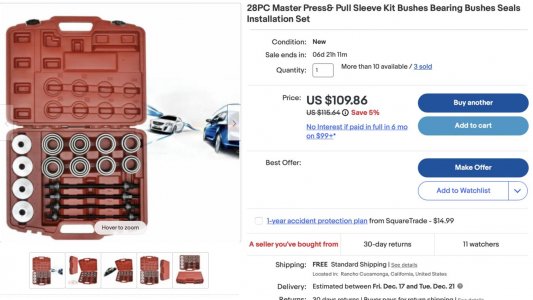
The tool is very easy to use. It's best used while the arm is on the car so you have leverage since you need a wrench in both hands, but you can throw it in a vice as well. My vice was not table mounted yet, so I decided to take the riskier route and use a impact on it. It's not necessarily recommended to use a power tool because you can easily strip out the threads on the threaded rods but I made sure the threads were lubed and I took it slow at a 1/4 turn at a time. (On my S2000, when the arm was mounted to the car, it was very easy to swap a bushing with just a crescent wrench in one hand and a ratcheting wrench in the other. Should be just as easy to use two wrenches if you have a table mounted vice).
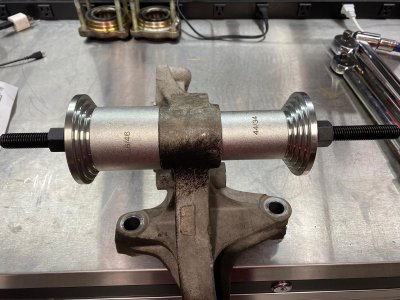
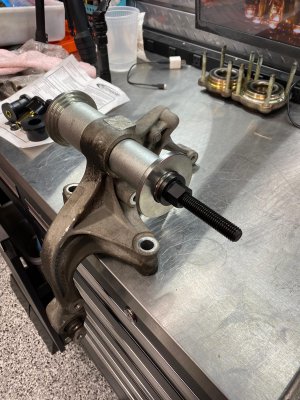
The two bushings for the front upright measure 44mm OD (Camber bushing) and 34mm OD (Upper). The Press & Pull sleeve kit came with all the proper size sleeves except for the upper bushing which was too small so I ended up using a 1/2" drive 24mm Tekton impact socket with an outer diameter of 33.8 mm. Any socket with the proper outer diameter should work, I just chose an impact since the walls were thicker and less likely to slip off the OEM bushing's outer sleeve. I used the socket with the Press & Pull sleeve kit, simply in place of one of the kit's sleeves. The picture shows the sizes of the sleeves used and what I assume to be the inner and outer metric diameters. Even though I used a 44mm sleeve to press the 44mm bushing out, the sleeve was ever so slightly smaller than the bushing so the sleeve slid in and out of the upright without issue (which is something I constantly checked throughout the install to make sure I didn't inadvertently get a sleeve stuck in the upright). The pic shows 4 sleeves (3 sleeves & 1 socket) because two were used to press and the other two were used to receive.
To press the Prothane bushings in, I just flipped the silver stop plate discs around so it had a wide flat surface to sit against the bushings (sorry no pics). Takes very little effort to press them in.
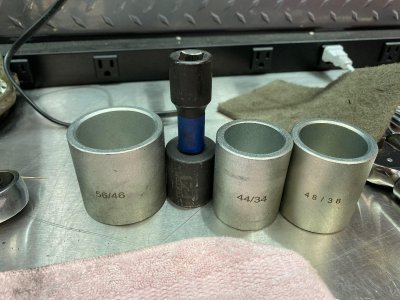
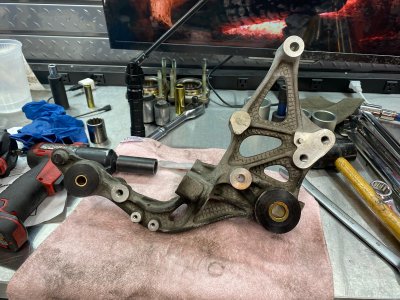
Last edited:
Wow. THANK YOU for posting this.
- Joined
- 3 May 2020
- Messages
- 148
No problem, did you end up doing yours yet?Wow. THANK YOU for posting this.
No problem, did you end up doing yours yet?
I'm still fumbling around with finding the right sized socket and cups. I should have bought that press and pull kit, but got this instead, and it doesn't have the same variety of sleeve sizes.
- Joined
- 3 May 2020
- Messages
- 148
I purchased the kit from the link I posted and received it in 3 days. Ordered Nov 27, received Nov 30. Might be a bit longer now since it's closer to the holidays, but IMO is very worth it. We all know having the right tools for the job makes it THAT much easier...and last thing you want is to make the job harder on yourself if you mess up the bushing or arm by not having the right size cups.I'm still fumbling around with finding the right sized socket and cups. I should have bought that press and pull kit, but got this instead, and it doesn't have the same variety of sleeve sizes.
Very welcome Regan. I wanted to film this for my channel (and still might in the future if i do the other side) but didn't get a chance to, so I'm happy my pictures and experience can help others.@Chris_Lum that's a hell of a post Chris. Thank you for sharing!!
btw.. having not done this yet, I assume the steering rack has to come off again, right? haha, as you know.. not my favorite job these days
Steering rack does not need to come off unless you do both sides at the same time. Since I only did the driver side, I left the steering rack bolted in on the passenger side. I tried to remove as little as possible. I ended up removing the coilover assembly and disconnecting the sway bar end link. I also removed the brake caliper and hung it to make the hub assembly lighter for when it came time to maneuver the arm back into place on assembly (also to save my ball joint boots because without the upper and lower arm bolts in place, the only things holding the arms in place are the compliance ball joints and the weight of the knuckle assembly with the brake caliper installed pulled the entire assembly down putting a lot of stress on the ball joints/boots). I also ended up disconnecting the steering tie rod end from the knuckle because i thought it might give me more freedom when trying to install the lower arm (a proper PITA) but i don't think it made a difference.
There were only two things that caught me up on this job, one was very minor:
There is a locator dowel on the upright that i didn't know existed, so i was trying to figure out why the upright wouldn't drop down even with all the bolts removed. I quickly realized it was pivoting like it was still bolted in at the center, so once i realized the locator dowel existed, I knew i simply needed to pry/push the upright forwards, away from the subframe before it would drop off.
The other thing, the major pain, was the fact that i had to shave the camber bushing down to get the arm on. In retrospect it would have made my life a lot easier if i shaved the bushings with the upright off of the car, but by the time i realized it was a problem, the upright was fully installed and i didn't want to disassemble. After an hour of struggling to get the arm on, i decided to take an angle grinder to the bushing. I don't want to suggest that you all need to do this...but it was the only option for me. The only other option was to separate the ball joints from the compliance and knuckle so that i could get the lower arm to go straight onto the bushing instead of swing on at an arc, but i didn't want to separate the bushings for various reasons. I will also stress that if anyone here decides to grind down your poly bushings, make sure you only grind the bushing and NOT the inner sleeve. I basically grinded just the rear lower side of the camber bushing into a cone shape so the arm would swing on without getting caught up on the shoulder of the bushing. I have no clue if this affects the performance of the bushing at all but I was at the point of no return by that point and getting very frustrated. My thoughts were that it should not affect the bushing since OEM bushings don't have that huge shoulder, but I'm no suspension or rubber/poly expert. You just need to make sure you don't grind the inner sleeve (that it stays the same length) because that's the dimension that needs to make contact with your arms when you tighten them down. Lastly, i used a grinder because i was losing patience and wanted it done quicker, but a razor blade cuts through the poly very easily in case you don't have a grinder.
Last edited:
I purchased the kit from the link I posted and received it in 3 days. Ordered Nov 27, received Nov 30. Might be a bit longer now since it's closer to the holidays, but IMO is very worth it. We all know having the right tools for the job makes it THAT much easier...and last thing you want is to make the job harder on yourself if you mess up the bushing or arm by not having the right size cups.
Very welcome Regan. I wanted to film this for my channel (and still might in the future if i do the other side) but didn't get a chance to, so I'm happy my pictures and experience can help others.
Steering rack does not need to come off unless you do both sides at the same time. Since I only did the driver side, I left the steering rack bolted in on the passenger side. I tried to remove as little as possible. I ended up removing the coilover assembly and disconnecting the sway bar end link. I also removed the brake caliper and hung it to make the hub assembly lighter for when it came time to maneuver the arm back into place on assembly (also to save my ball joint boots because without the upper and lower arm bolts in place, the only things holding the arms in place are the compliance ball joints and the weight of the knuckle assembly with the brake caliper installed pulled the entire assembly down putting a lot of stress on the ball joints/boots). I also ended up disconnecting the steering tie rod end from the knuckle because i thought it might give me more freedom when trying to install the lower arm (a proper PITA) but i don't think it made a difference.
There were only two things that caught me up on this job, one was very minor:
There is a locator dowel on the upright that i didn't know existed, so i was trying to figure out why the upright wouldn't drop down even with all the bolts removed. I quickly realized it was pivoting like it was still bolted in at the center, so once i realized the locator dowel existed, I knew i simply needed to pry/push the upright forwards, away from the subframe before it would drop off.
The other thing, the major pain, was the fact that i had to shave the camber bushing down to get the arm on. In retrospect it would have made my life a lot easier if i shaved the bushings with the upright off of the car, but by the time i realized it was a problem, the upright was fully installed and i didn't want to disassemble. After an hour of struggling to get the arm on, i decided to take an angle grinder to the bushing. I don't want to suggest that you all need to do this...but it was the only option for me. The only other option was to separate the ball joints from the compliance and knuckle so that i could get the lower arm to go straight onto the bushing instead of swing on at an arc, but i didn't want to separate the bushings for various reasons. I will also stress that if anyone here decides to grind down your poly bushings, make sure you only grind the bushing and NOT the inner sleeve. I basically grinded just the rear lower side of the camber bushing into a cone shape so the arm would swing on without getting caught up on the shoulder of the bushing. I have no clue if this affects the performance of the bushing at all but I was at the point of no return by that point and getting very frustrated. My thoughts were that it should not affect the bushing since OEM bushings don't have that huge shoulder, but I'm no suspension or rubber/poly expert. You just need to make sure you don't grind the inner sleeve (that it stays the same length) because that's the dimension that needs to make contact with your arms when you tighten them down. Lastly, i used a grinder because i was losing patience and wanted it done quicker, but a razor blade cuts through the poly very easily in case you don't have a grinder.
Super great info. Thanks again. Now I feel a little better prepared to.... HAVE YOU DO THIS FOR ME. I kid... haha
- Joined
- 3 May 2020
- Messages
- 148
Super great info. Thanks again. Now I feel a little better prepared to.... HAVE YOU DO THIS FOR ME. I kid... haha
If you want to bring your upright down to Irvine, I'd be more than happy to remove and install the bushings for you. You're on your own reassembling the car though :biggrin:
You are too kind! I might have to take you up on that someday (or rather perhaps on a work night!)
That was so good. Now i'm actually motivated to do this
Even though this is probably outside of my realm of expertise for completing, I appreciate recording this into great detail. Helps me to slowly learn how these cars were engineered. Are bushings best replaced due to aging, miles, or combination of both?
Similar threads
- Replies
- 0
- Views
- 80
- Replies
- 4
- Views
- 3K








